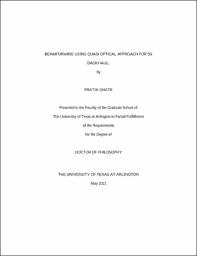
ATTENTION: The works hosted here are being migrated to a new repository that will consolidate resources, improve discoverability, and better show UTA's research impact on the global community. We will update authors as the migration progresses. Please see MavMatrix for more information.
Show simple item record
| dc.contributor.advisor | Bredow, Jonathan | |
| dc.creator | Ghate, Pratik | |
| dc.date.accessioned | 2021-11-12T17:47:32Z | |
| dc.date.available | 2021-11-12T17:47:32Z | |
| dc.date.created | 2021-05 | |
| dc.date.issued | 2021-05-06 | |
| dc.date.submitted | May 2021 | |
| dc.identifier.uri | http://hdl.handle.net/10106/30064 | |
| dc.description.abstract | A new method is proposed for quasi optical beamforming that will enhance performance of emerging systems such as broad deployment of 5G backhaul communications, Internet of Things (IOT), vehicular networking systems, and unmanned aerial navigation systems. It is a promising approach at higher frequencies to reduce the size, cost and improve efficiency of the beamforming operation.
In this investigation candidate lens type structures are designed, studied, and analyzed using different configurations of dielectric wedges, plano-concave lens and dielectric slabs. These structures have cost, power consumption, size, weight, and bandwidth advantages, and are expected to be able to operate to higher frequencies than other beamformers in current use. The proposed structures give sufficient degrees of freedom to control the beamsteering by varying the dielectric constants and geometries of these structures and can form multiple minimally overlapping. This technique is valid for E and H principal planes.
Beamforming control with these and other electrically similar types of structures is expected to be achievable with vertical broadside coupled split ring resonators to control the beamsteering angles and beamwidth control. This approach gives sufficient degrees of freedom for steering the beam in E and H principal planes by adjusting the placement of vertical broadside coupled split ring resonators and their arrays. This approach increases the gain of the radiating source resulting in highly directive beams with sufficient degrees of freedom to electronically tune beam properties.
Four different geometries are proposed, and performance is demonstrated for quasi- optical beamforming approach. These structures are designed for 1x3 patch antenna to demonstrate the formation of three minimally overlapping beams. Bandwidth enhancement and scanning angle of 180° has been achieved by using vertically oriented dielectric wedge. 6 dB gain enhancement and the capability to scale to somewhat larger arrays has also been demonstrated. Full wave simulations in Ansys HFSS are provided to support the proposed techniques of beamforming using quasi- optical (lens type) structures and validations are done in CST MWS. | |
| dc.format.mimetype | application/pdf | |
| dc.language.iso | en_US | |
| dc.subject | Beamforming | |
| dc.subject | Beamsteering | |
| dc.subject | Quasi-optical | |
| dc.subject | Antennas | |
| dc.title | BEAMFORMING USING QUASI OPTICAL APPROACH FOR 5G BACKHAUL | |
| dc.type | Thesis | |
| dc.contributor.committeeMember | Davis, Alan | |
| dc.degree.department | Electrical Engineering | |
| dc.degree.name | Doctor of Philosophy in Electrical Engineering | |
| dc.date.updated | 2021-11-12T17:47:33Z | |
| thesis.degree.department | Electrical Engineering | |
| thesis.degree.grantor | The University of Texas at Arlington | |
| thesis.degree.level | Doctoral | |
| thesis.degree.name | Doctor of Philosophy in Electrical Engineering | |
| dc.type.material | text | |
| dc.creator.orcid | 0000-0003-0313-6184 | |
Files in this item
- Name:
- GHATE-DISSERTATION-2021.pdf
- Size:
- 3.437Mb
- Format:
- PDF
This item appears in the following Collection(s)
Show simple item record


